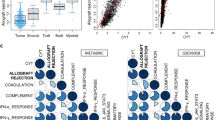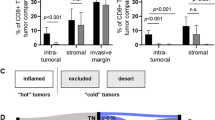Abstract
The expression of major histocompatibility complex class I (MHC I) in tumor cells is regulated by interferon signaling, and it is an important factor in the efficacy of cytotoxic T cell–dependent immunotherapy. To determine the impact of immune cells in MHC I expression on tumor cells, we compared the expression of MHC I in tumor cells derived from primary breast cancers and patient-derived xenograft (PDX) models. MHC I and myxovirus resistance gene A (MxA) expression were analyzed using immunohistochemistry in 23 cases of tumor tissue and corresponding primary and secondary PDXs. The median H score of MHC I was 210 (0–300) in patient tumor tissues, 197.5 (0–300) in primary PDX tumors, and 157.5 (5–300) in secondary PDX tumors. Cases were divided into four groups based on the difference in MHC I expression between the patient tumor tissues and secondary PDXs. Eleven cases constituted the high MHC I group, four constituted the low MHC I group, six comprised the decreased MHC I group, and two comprised the increased MHC I group. MHC I and MxA expressions in each tumor were weakly correlated within patients’ tumors, while strongly correlated within PDX models. Retained or altered expression of MHC I in breast cancer PDXs reveals the presence of intrinsic and extrinsic interferon signaling pathways in tumor cells. Thus, considering MHC I expression in PDX is important when using PDX models to evaluate the efficacy of cancer immunotherapy in a preclinical setting.



Similar content being viewed by others
References
Zheng PP, Kros JM, Li J. Approved CAR T cell therapies: ice bucket challenges on glaring safety risks and long-term impacts. Drug Discov Today. 2018. https://doi.org/10.1016/j.drudis.2018.02.012.
Gong J, Chehrazi-Raffle A, Reddi S, Salgia R. Development of PD-1 and PD-L1 inhibitors as a form of cancer immunotherapy: a comprehensive review of registration trials and future considerations. J Immunother Cancer. 2018;6(1):8. https://doi.org/10.1186/s40425-018-0316-z.
Chae YK, Oh MS, Giles FJ. Molecular biomarkers of primary and acquired resistance to T-cell-mediated immunotherapy in cancer: landscape, clinical implications, and future directions. Oncologist. 2018;23(4):410–21. https://doi.org/10.1634/theoncologist.2017-0354.
Agrawal S, Kishore MC. MHC class I gene expression and regulation. J Hematother Stem Cell Res. 2000;9(6):795–812. https://doi.org/10.1089/152581600750062237.
Silginer M, Nagy S, Happold C, Schneider H, Weller M, Roth P. Autocrine activation of the IFN signaling pathway may promote immune escape in glioblastoma. Neuro-Oncology. 2017;19(10):1338–49. https://doi.org/10.1093/neuonc/nox051.
Hu JL, Hua YJ, Chen Y, Yu B, Gao S. Structural analysis of tumor-related single amino acid mutations in human MxA protein. Chin J Cancer. 2015;34(12):583–93. https://doi.org/10.1186/s40880-015-0055-1.
Lee HJ, Song IH, Park IA, Heo SH, Kim YA, Ahn JH, et al. Differential expression of major histocompatibility complex class I in subtypes of breast cancer is associated with estrogen receptor and interferon signaling. Oncotarget. 2016;7(21):30119–32. https://doi.org/10.18632/oncotarget.8798.
Kim YA, Lee HJ, Heo SH, Park HS, Park SY, Bang W, et al. MxA expression is associated with tumor-infiltrating lymphocytes and is a prognostic factor in triple-negative breast cancer. Breast Cancer Res Treat. 2016;156(3):597–606. https://doi.org/10.1007/s10549-016-3786-z.
Whittle JR, Lewis MT, Lindeman GJ, Visvader JE. Patient-derived xenograft models of breast cancer and their predictive power. Breast Cancer Res. 2015;17:17. https://doi.org/10.1186/s13058-015-0523-1.
Salgado R, Denkert C, Demaria S, Sirtaine N, Klauschen F, Pruneri G, et al. The evaluation of tumor-infiltrating lymphocytes (TILs) in breast cancer: recommendations by an International TILs Working Group 2014. Ann Oncol. 2015;26(2):259–71. https://doi.org/10.1093/annonc/mdu450.
Harvey JM, Clark GM, Osborne CK, Allred DC. Estrogen receptor status by immunohistochemistry is superior to the ligand-binding assay for predicting response to adjuvant endocrine therapy in breast cancer. J Clin Oncol. 1999;17(5):1474–81. https://doi.org/10.1200/JCO.1999.17.5.1474.
Wolff AC, Hammond ME, Hicks DG, Dowsett M, McShane LM, Allison KH, Allred DC, Bartlett JM, Bilous M, Fitzgibbons P, Hanna W, Jenkins RB, Mangu PB, Paik S, Perez EA, Press MF, Spears PA, Vance GH, Viale G, Hayes DF, American Society of Clinical O, College of American P (2014) Recommendations for human epidermal growth factor receptor 2 testing in breast cancer: American Society of Clinical Oncology/College of American Pathologists clinical practice guideline update. Arch Pathol Lab Med 138 (2):241–256. doi:https://doi.org/10.5858/arpa.2013-0953-SA.
WHO classification of tumours of the breast (2012). 4th. International Agency for Research on Cancer
Cerami E, Gao J, Dogrusoz U, Gross BE, Sumer SO, Aksoy BA, et al. The cBio cancer genomics portal: an open platform for exploring multidimensional cancer genomics data. Cancer Discov. 2012;2(5):401–4. https://doi.org/10.1158/2159-8290.CD-12-0095.
Gao J, Aksoy BA, Dogrusoz U, Dresdner G, Gross B, Sumer SO, et al. Integrative analysis of complex cancer genomics and clinical profiles using the cBioPortal. Sci signal. 2013;6(269):pl1-pl1. https://doi.org/10.1126/scisignal.2004088.
Fleming JM, Miller TC, Meyer MJ, Ginsburg E, Vonderhaar BK. Local regulation of human breast xenograft models. J Cell Physiol. 2010;224(3):795–806. https://doi.org/10.1002/jcp.22190.
Ben-David U, Ha G, Tseng YY, Greenwald NF, Oh C, Shih J, et al. Patient-derived xenografts undergo mouse-specific tumor evolution. Nat Genet. 2017;49(11):1567–75. https://doi.org/10.1038/ng.3967.
Eirew P, Steif A, Khattra J, Ha G, Yap D, Farahani H, et al. Dynamics of genomic clones in breast cancer patient xenografts at single-cell resolution. Nature. 2015;518(7539):422–6. https://doi.org/10.1038/nature13952.
Izumchenko E, Paz K, Ciznadija D, Sloma I, Katz A, Vasquez-Dunddel D, et al. Patient-derived xenografts effectively capture responses to oncology therapy in a heterogeneous cohort of patients with solid tumors. Ann Oncol. 2017;28(10):2595–605. https://doi.org/10.1093/annonc/mdx416.
Everson RG, Antonios JP, Lisiero DN, Soto H, Scharnweber R, Garrett MC, et al. Efficacy of systemic adoptive transfer immunotherapy targeting NY-ESO-1 for glioblastoma. Neuro-Oncology. 2016;18(3):368–78. https://doi.org/10.1093/neuonc/nov153.
Jespersen H, Lindberg MF, Donia M, Soderberg EMV, Andersen R, Keller U, et al. Clinical responses to adoptive T-cell transfer can be modeled in an autologous immune-humanized mouse model. Nat Commun. 2017;8(1):707. https://doi.org/10.1038/s41467-017-00786-z.
De La Rochere P, Guil-Luna S, Decaudin D, Azar G, Sidhu SS, Piaggio E. Humanized mice for the study of immuno-oncology. Trends Immunol. 2018;39(9):748–63. https://doi.org/10.1016/j.it.2018.07.001.
Capasso A, Lang J, Pitts TM, Jordan KR, Lieu CH, Davis SL, et al. Characterization of immune responses to anti-PD-1 mono and combination immunotherapy in hematopoietic humanized mice implanted with tumor xenografts. Journal for ImmunoTherapy of Cancer. 2019;7(1):37. https://doi.org/10.1186/s40425-019-0518-z.
Li H, Zhu Y, Tang X, Li J, Li Y, Zhong Z, et al. Integrated analysis of transcriptome in cancer patient-derived xenografts. PLoS One. 2015;10(5):e0124780. https://doi.org/10.1371/journal.pone.0124780.
Wang D, Li JR, Zhang YH, Chen L, Huang T, Cai YD. Identification of differentially expressed genes between original breast cancer and xenograft using machine learning algorithms. Genes (Basel). 2018;9(3). https://doi.org/10.3390/genes9030155.
Kaur G, Batra S. Emerging role of immunoproteasomes in pathophysiology. Immunol Cell Biol. 2016;94(9):812–20. https://doi.org/10.1038/icb.2016.50.
Gresser I, Maury C, Brouty-Boye D. Mechanism of the antitumour effect of interferon in mice. Nature. 1972;239(5368):167–8.
Brockwell NK, Parker BS. Tumor inherent interferons: impact on immune reactivity and immunotherapy. Cytokine. 2018. https://doi.org/10.1016/j.cyto.2018.04.006.
Weiss JM, Subleski JJ, Back T, Chen X, Watkins SK, Yagita H, et al. Regulatory T cells and myeloid-derived suppressor cells in the tumor microenvironment undergo Fas-dependent cell death during IL-2/αCD40 therapy. Journal of immunology (Baltimore, Md : 1950). 2014;192(12):5821–9. https://doi.org/10.4049/jimmunol.1400404.
Sisirak V, Faget J, Gobert M, Goutagny N, Vey N, Treilleux I, et al. Impaired IFN-α production by plasmacytoid dendritic cells favors regulatory T-cell expansion that may contribute to breast cancer progression. Cancer Res. 2012;72(20):5188–97. https://doi.org/10.1158/0008-5472.CAN-11-3468.
Sistigu A, Yamazaki T, Vacchelli E, Chaba K, Enot DP, Adam J, et al. Cancer cell-autonomous contribution of type I interferon signaling to the efficacy of chemotherapy. Nat Med. 2014;20(11):1301–9. https://doi.org/10.1038/nm.3708.
Funding
This work was supported by the Korean Health Technology R&D Project, Ministry of Health & Welfare (HI15C0708 and HI17C0337); Basic Science Research Programs through the National Research Foundation of Korea (NRF) funded by the Ministry of Science, ICT & Future Planning, Republic of Korea (NRF-2016R1D1A1B03935367 and NRF-2018R1D1A1B07040612); and the Asan Institute for Life Sciences, Asan Medical Center, Seoul, Korea (2016-169).
Author information
Authors and Affiliations
Corresponding authors
Ethics declarations
Conflict of interest
The authors declare that that they have no conflict of interest.
Ethical approval
This study was performed in accordance with the Declaration of Helsinki and was approved by the Institutional Review Board of Asan Medical Center (IRB#2015-0438) and the International Animal Care and Use Committee (IACUC) of the Laboratory of Animal Research at the Asan Medical Center, Seoul, Republic of Korea.
Informed consent
Informed consent was obtained from all individual participants included in the study.
Additional information
Publisher’s note
Springer Nature remains neutral with regard to jurisdictional claims in published maps and institutional affiliations.
Précis
Tumor cells derived from PDX models showed retainment or alteration of MHC I expression. Thus, considering MHC I expression in PDX is important when using PDX models to evaluate the efficacy of cancer immunotherapy in a preclinical setting.
Electronic supplementary material
ESM 1
(PDF 447 kb)
Rights and permissions
About this article
Cite this article
Song, I.H., Kim, YA., Lee, H. et al. Retained or altered expression of major histocompatibility complex class I in patient-derived xenograft models in breast cancer. Immunol Res 67, 469–477 (2019). https://doi.org/10.1007/s12026-019-09109-4
Published:
Issue Date:
DOI: https://doi.org/10.1007/s12026-019-09109-4




